
Volume
27, No. 3 – March 2014
Volume 27, No. 3
Editor: Stephen L. Seftenberg
Website:
www.CivilWarRoundTablePalmBeach.org
March 12, 2014 Program
The Round Table is honored to have the distinguished lecturer and
nationally renowned historian, James "Bud" Robertson
speaking at the March meeting. I have had the privilege of hearing Dr.
Robertson, and it is not to be missed. His reputation extends well
beyond the campus of Virginia Tech. Dr. Robertson is the author of more
than 20 books and has received every major award in Civil War history.
His highly acclaimed biography of Stonewall Jackson, Gods and
Generals, is considered the definitive biography of Jackson. The
movie "Gods and Generals" was based on that book
with Dr. Robertson serving as historical consultant. His topic will be
the "Untold Civil War."
February 11, 2014 Program
Lawrence Lee Hewitt: "Civil War Myths, Mistakes and Fabrications "
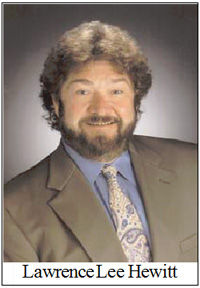 Lawrence
Lee Hewitt (B.A. University of Kentucky, Ph.D. Louisiana State
University, professor emeritus Southeastern Louisiana University)has
received awards from the Civil War Roundtables of New Orleans and
Chicago and the President’s Award for Excellence in Research,
Southeastern Louisiana University’s highest award. Among his many
publications are Port Hudson, Confederate Bastion on the Mississippi,
The Confederate High Command & Related Topics, Leadership During the
Civil War, and 200 Years a Nation. Lawrence
Lee Hewitt (B.A. University of Kentucky, Ph.D. Louisiana State
University, professor emeritus Southeastern Louisiana University)has
received awards from the Civil War Roundtables of New Orleans and
Chicago and the President’s Award for Excellence in Research,
Southeastern Louisiana University’s highest award. Among his many
publications are Port Hudson, Confederate Bastion on the Mississippi,
The Confederate High Command & Related Topics, Leadership During the
Civil War, and 200 Years a Nation.
Hewitt began by defining myth as something that people
wrongly believe to be true. The mythmakers are either supposed
eyewitnesses or historians writing after the fact. It is the job of the
latter to ferret out and expose the mistakes or lies of the former, but
sometimes they find that a dubious story is just too good not to retell.
Sometimes the historian is mislead by the available evidence. Even the
best historian can make mistakes. Worse, some historians and even
eyewitnesses fabricate stories for various reasons. Joseph Goebbels
observed that if a lie is repeated often enough, it becomes the “truth.”
He had nothing on some Civil War writers.
Honest Mistakes
Ed Bearss and Tim Smith, both highly respected Civil War authors,
have mistakenly perpetuated a not so trivial mistake. For the death of
Lloyd Tilghman at Champion Hill, both cite an 1893 "eyewitness" account
by "F.W.M." in the magazine Confederate Veteran. Veterans often
challenge accounts of others, and veteran E. T. Eggleston responded in
the very next issue that "F.W.M." was 1st Lieutenant F. W. Merrin, who
had been ordered to the rear nearly four hours before Tilghman was
killed, so Merrin could not have been an "eyewitness." Bearss and Smith
never changed their story. I guess they missed Eggleston’s
response.
Even the Official Records can err. They state that Brigadier General
John Roane accompanied Major General Earl Van Dorn from Arkansas
to Mississippi in the spring of 1862, and participated in the siege of
Corinth. The facts are that Roane was left charge in Arkansas and was
never at Corinth. Bruce Aliardice got it right in More Confederate
Generals, the first of us to do so.
Fabrications
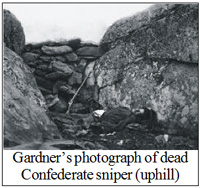 Nearly
twenty years ago Marshal Krolick (a member of both Chicago and Palm
Beach County Roundtables) asked me to find the source for a conversation
between Robert E. Lee and Jeb Stuart on the afternoon of July 2, 1863. I
was unaware that he was testing me. I failed to find it in any of the
accounts left by Lee's staff officers, but in John Thomason's Jeb
Stuart, published in 1934, Thomason wrote," ‘Well, General Stuart,
you are here at last!' says Lee, austerely. "Douglas Southall Freeman,
in Lee's Lieutenants, carefully stated "The tradition is that Lee
said, 'Well, General Stuart, you are here at last," omitting
"austerely.' In 1957, Burke Davis, in Jeb Stuart, added: "Lee
reddened at sight of Stuart and raised his arm as if he Nearly
twenty years ago Marshal Krolick (a member of both Chicago and Palm
Beach County Roundtables) asked me to find the source for a conversation
between Robert E. Lee and Jeb Stuart on the afternoon of July 2, 1863. I
was unaware that he was testing me. I failed to find it in any of the
accounts left by Lee's staff officers, but in John Thomason's Jeb
Stuart, published in 1934, Thomason wrote," ‘Well, General Stuart,
you are here at last!' says Lee, austerely. "Douglas Southall Freeman,
in Lee's Lieutenants, carefully stated "The tradition is that Lee
said, 'Well, General Stuart, you are here at last," omitting
"austerely.' In 1957, Burke Davis, in Jeb Stuart, added: "Lee
reddened at sight of Stuart and raised his arm as if he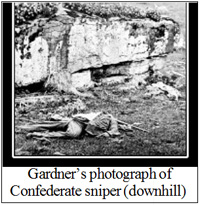 would strike him. ‘General Stuart, where have you been?’" Davis's
fabrication failed to catch on, while Thomason's fabrication lives on,
even being used in the movie Gettysburg. The truth is no one will
ever know what Lee said when he greeted Stuart because no one else was
present and neither Lee nor Stuart left an account of the meeting. Now
consider for a moment that at the time Stuart entered Lee's tent the
Union Army of the Potomac was on the ropes and Lee was sure
he was about to deliver a knockout blow. Wasn't Stuart’s arrival all
that Lee could have wished for? Isn't it possible that Lee did raise his
arms when Stuart entered, not to strike him but to give him a big hug,
perhaps even saying "Well, General Stuart, you are here at last!"
would strike him. ‘General Stuart, where have you been?’" Davis's
fabrication failed to catch on, while Thomason's fabrication lives on,
even being used in the movie Gettysburg. The truth is no one will
ever know what Lee said when he greeted Stuart because no one else was
present and neither Lee nor Stuart left an account of the meeting. Now
consider for a moment that at the time Stuart entered Lee's tent the
Union Army of the Potomac was on the ropes and Lee was sure
he was about to deliver a knockout blow. Wasn't Stuart’s arrival all
that Lee could have wished for? Isn't it possible that Lee did raise his
arms when Stuart entered, not to strike him but to give him a big hug,
perhaps even saying "Well, General Stuart, you are here at last!"
Part of the historian's job is to give their best guess in the
absence of definitive evidence and make it clear to the reader that it
is only an opinion. lt is not unusual for such assumptions to be
challenged. Alexander Gardner's "Home of a Rebel Sharpshooter" is
one of the most famous photographs of the Civil War. In 1961, Frederic
Ray, in Civil War Times Magazine, demonstrated that the body of
the sharpshooter had also been photographed in a second location, 70
yards away. In 1975, William Frassanito, in Gettysburg: A Journey in
Time, erroneously stated that Ray had claimed that Gardner and his
two assistants had moved the body up the hill to stage a better
composition using the boulders and rock wall in Devil's Den. In 1995
Frassanito, in Early Photography at Gettysburg, acknowledged that
Ray never claimed that the body had been moved up the hill and admitted
that he couldn't prove which way the body had been moved. But the
National Park Service had already accepted his 1975 claim, labeled the
uphill sharpshooter photograph as a fake, and continues to do so. In an
article published in 1998, James Groves claimed that the first,
unstaged, shot was of the body up the hill. Unlike Frassanito, Groves
provided an eyewitness account of the death of the sharpshooter and gave
two reasons why Gardner would have wanted to move the body down the
hill.
I agree with Groves that the uphill sharpshooter image is the
unstaged one. My evidence for this is his mangled right leg.
According to Dr. Edgardo Rodriguez, who specializes in complex trauma to
the lower extremity, only two possibilities explain the position of the
sharpshooter's pelvis, right leg, and right foot in the photographs
taken down the hill: tibial fracture or knee disarticulation and
dislocation. Nothing visible on the pants leg indicate that a projectile
caused the injury; nor could it have been sustained by being blown onto
his back by the concussion from an exploding artillery shell. For all
the controversy surrounding the photographs, two things are certain. The
subject was killed, and his right leg sustained one of two possible
injuries, neither of which would have proved fatal. Also, no external
wounds are visible. Neither concussion nor a fatal shot in the back
could have caused his leg injury. But the concussion that killed him in
the Devil’s Den probably also caused at least one large stone to topple
from the wall onto his lower right leg. As the photographer set up the
camera his assistants removed any stones from the body. That was the
only "staging" that occurred. For those who doubt my conclusion,
consider this: There are no photographs of the body in a third location
and no other photographer or artist captured the image uphill at the
wall. If Gardner had staged the shot at the wall would he have left the
body there for his competitors to copy?
Misunderstandings
 
Smoothbore shoulder weapons had an effective range of 50 yards;
rifles prior to 1855 had an effective range of 200 yards. In an 1861
Springfield rifled-musket, the minié ball was accurate at 400 yards and
could kill at 1000 yards; it was also faster to load than the pre 1855
rifles. Foremost among the historians who understood the significance of
the minié ball as well as the rifled-musket and who argue that they made
earlier tactics obsolete are the late Grady McWhiney and Perry Jamieson,
who published Attack and Die in 1982. The title says it all. Massed
assaults by infantry were likely to be both costly and unsuccessful
because of the increased range of the defender's weapons. Two
historians, however, argue that the tactics used by Civil War generals
were not outdated because of how these longer ranged weapons were
actually used. The only American historian to seriously consider the
topic is Earl Hess, who published The Rifle Musket in Civil War Combat:
Reality and Myth in 2008. Hess argued that the rifle's potential to
alter the outcome of a battle at a distance was nullified for a variety
of reasons. Possibly the most significant was that defenders were seldom
ordered to begin firing until the enemy was within 200 yards, and with
good reason. One thing Hess mentioned (and other historians seldom
consider) is how many rounds a soldier carried into battle (40-60) and
how many of those could be fired before the gunpowder fouled the rifle
(approximately 20 for Confederates and maybe 40 for Union soldiers
having cleaner bullets). Cleaning a fouled rifle required at least
partial dismantling and was easier with water. What soldier would want
to be caught with a useless rifle when the enemy is close?
Much has been written about Civil War commanders who fought the war
with tactics made obsolete by the rifle. Historians still condemn their
stupidity, but few historians have realized what Jefferson Davis did in
1855. It was not the rifled barrel that was revolutionary, it was
the minié ball.
Was the Trans-Mississippi the "Junkyard of the
Confederate Army"?
"Huey, Dewey and Louie?"
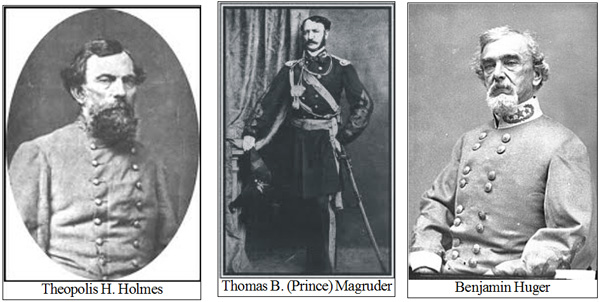
The transfers to the West of the three Generals pictured above
supposedly supports Albert Castel’s reference to the Trans-Mississippi
theater as "the junkyard of the Confederate Army," where those found
wanting in the East were sent to limit the harm they could do. William
C. Davis amplified this dumping ground theme when he wrote that "in the
summer of 1862 President Jefferson Davis began a war-long policy of
sending discredited or incompetent generals [West] to command or using
it to shelve personal favorites who had become too controversial to keep
in the East." Craig Symonds also weighed in: "When Robert E. Lee took
over the command of the Army in Virginia... he measured his subordinate
commanders by a simple standard: success. When a particular officer
proved himself in combat, Lee promoted him; when he did not, Lee did not
demote him. . ., instead he contrived to have him sent to another
theater, generally to the West. Without saying so, Lee used the West
or actually any theater outside Virginia as a dumping ground for
officers he did not want around him any more." Let’s check the
record:
Thomas B. ("Prince") Magruder was ordered to the
Trans-Mississippi in May 1862, before Lee took command of the
army. His transfer was delayed so he could face a courts-martial for
drunkenness during the Seven Days' Battles in Richmond. During May, June
and July, while Magruder remained in Virginia, Major General
Hindman, commander of the Trans-Mississippi north of the Red River, so
alienated the politicians there that Davis promised to replace him. When
Magruder could not take over promptly, Davis sent the only officer
available who outranked Hindrnan: Theopolis H. Holmes. Lee had
nothing to do with the departure of either Magruder or Holmes! Before
the start of the Seven Days' Battles, Lee had urged Davis to send
Benjamin Huger to South Carolina to replace the unpopular and
suspected traitor John Pemberton. Longstreet's lies about Huger's
performance during the Seven Days' caused Huger instead to be
transferred to the Texas coast, where his ordnance talents were
desperately needed.
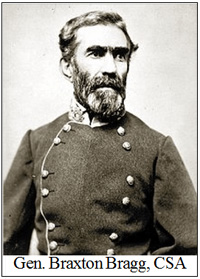 The
record does not bear out the slur: A total of 73 Confederate
generals served in the Trans-Mississippi. Of these, 38 served only West
of the Mississippi; 4 were transferred East; 7 sent West were later
transferred back East; 13 were either requested by Kirby Smith,
requested the transfer themselves, or obtained a leave of absence on
their own to go there; 3 were sent only because of disabling wounds; and
1 was sent because his brigade had been captured at Vicksburg but
paroled West of the Mississippi. A total of 66 (90.4%) could not
be considered to have been dumped there. Among the 7 remaining, John G.
Walker was transferred from the Army of Northern Virginia over Lee's
written objection; and William Preston had been transferred to the
Trans-Mississippi by Bragg for disloyalty rather than incompetence. Even
if the remaining 5 were the worst generals in the Confederacy it would
not make the Trans-Mississippi a dumping ground. And they were not:
Sibley started there and Polk, Northrop, and Floyd never served West of
the Mississippi. The fifth one Hewitt left for us to discover. The
record does not bear out the slur: A total of 73 Confederate
generals served in the Trans-Mississippi. Of these, 38 served only West
of the Mississippi; 4 were transferred East; 7 sent West were later
transferred back East; 13 were either requested by Kirby Smith,
requested the transfer themselves, or obtained a leave of absence on
their own to go there; 3 were sent only because of disabling wounds; and
1 was sent because his brigade had been captured at Vicksburg but
paroled West of the Mississippi. A total of 66 (90.4%) could not
be considered to have been dumped there. Among the 7 remaining, John G.
Walker was transferred from the Army of Northern Virginia over Lee's
written objection; and William Preston had been transferred to the
Trans-Mississippi by Bragg for disloyalty rather than incompetence. Even
if the remaining 5 were the worst generals in the Confederacy it would
not make the Trans-Mississippi a dumping ground. And they were not:
Sibley started there and Polk, Northrop, and Floyd never served West of
the Mississippi. The fifth one Hewitt left for us to discover.
As for Lee, he was no different than any other senior commander.
Bragg got rid of several generals for multiple reasons, and Kirby Smith
even got rid of Richard Taylor, his best subordinate, for personal
reasons. Nor did Lee always got what he wanted. I've already mentioned
Hill and Walker. Lee would have preferred to have kept Richard Taylor
and Wade Hampton but he knew better than to ask, and Davis forced Lee to
relieve Jubal Early. Lastly, Lee on one occasion even used Virginia as a
dumping ground, transferring Richard Ewell to the Department of
Richmond.
Braxton Bragg was, and remains, an easy target for
fabrications. The most ridiculing story about Bragg allegedly occurred
prior to the Mexican War when 1st Lt. Bragg found himself acting as both
company commander and post quartermaster. "As commander of the company
he made a requisition upon the quartermaster [that is, himself] for
something he wanted. As quartermaster he declined to fill the
requisition, and endorsed on the back of it his reasons for so doing. As
company commander he responded to this, urging that his requisition
called for nothing but what he was entitled to, and that it was the duty
of the quartermaster to fill it. As quartermaster he still persisted
that he was right. In this condition of affairs Bragg referred the whole
matter to the commanding officer of the post. The latter exclaimed: "My
God, Mr. Bragg, you have quarreled with every officer in the army, and
now you are quarreling with yourself!" The source for this is the
Personal Memoirs of U. S. Grant, published in 1885. The story went
undisputed until 2011, when Samuel Martin began his biography of Bragg
with Grant's story, and concluded, correctly: "Grant's humorous tale is
obviously false."
One of the most harmful fabricated Bragg tales regards his
relationship with Nathan Bedford Forrest. These are the facts: In
June of 1862, Beauregard persuaded Colonel Forrest to give up his
regiment and go to East Tennessee to take command of the cavalry in the
vicinity of Chattanooga, hinting that he would be promoted to Brigadier
General if he did so. Bragg was not involved. By the time Forrest was
promoted to brigadier in July, Bragg had replaced Beauregard and was
moving toward East Tennessee himself, where Bragg welcomed Forrest as
commander of all his cavalry. In September during the invasion of
Kentucky, Forrest's horse fell and then rolled over on him, dislocating
his right shoulder. Confined to a buggy and unable to keep up with his
command, Bragg ordered him to Murfreesboro with a small contingent.
There he was to recruit additional regiments and harass the enemy. There
was no animosity on the part of either of them regarding this assignment
because Bragg had allowed Forrest to save face. When Bragg organized the
Army of Tennessee in November, he placed Joseph Wheeler in command of
all his cavalry except for the brigades of Forrest and John Hunt Morgan.
This was done because Forrest and Morgan both outranked Wheeler, and
because Forrest and Morgan had demonstrated greater ability at
conducting raids than in gathering intelligence. Forrest preferred the
freedom this assignment allowed him so there was no cause for hard
feelings on his part. In February 1863, while Forrest was on leave,
Wheeler borrowed 800 of Forrest's men for a raid against Dover,
Tennessee. When Forrest learned of this he managed to join his men just
before Wheeler ordered the town attacked. Forrest objected to Wheeler's
plan, but Wheeler, now a major general, proceeded. It turned out to be a
disaster and Forrest refused to ever serve under Wheeler again. The
Bragg of myth would have sacked Forrest for insubordination; the real
Bragg honored Forrest's request by transferring Forrest--and his
brigade---to Major General Earl Van Dorn's cavalry corps. Following Van
Dorn's assassination by a jealous husband, Bragg offered to have Forrest
promoted to major general but Forrest declined; Bragg gave him Van
Dorn's command anyway. In late September, while on leave, Forrest
learned that Bragg had assigned some of his men to Wheeler. When Forrest
protested, Bragg assured him that the men would be returned to his
command when he returned from his leave and Forrest acquiesced.
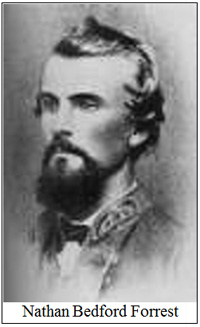 Every
modern biography of Forrest and of Bragg contains the following dramatic
but false story: Sometime during the fall of 1863 Forrest stormed into
Bragg's tent. Bragg rose and extended his hand: "Refusing to take the
proffered hand, and standing stiff and erect before Bragg, Forrest said:
"I am not here to pass civilities or compliments with you, but on other
business. You commenced your cowardly and contemptible persecution of me
soon after the battle of Shiloh, and you have kept it up ever since. You
did it because I reported to Richmond facts, while you reported damned
lies. You robbed me of my command in Kentucky, that I armed and equipped
from the enemies of our country, and gave it to one of your favorites.
In a spirit of revenge and spite, because I would not fawn upon you as
others did, you drove me into West Tennessee in the winter of 1862, with
a second brigade I had organized, with improper arms and without
sufficient ammunition, although 1 had made repeated applications for the
same. You did it to ruin me and my career. When in spite of all this I
returned with my command, well equipped by captures, you began again
your work of spite and persecution, and have kept it up; and now this
second brigade, organized and equipped without thanks to you or the
government, a brigade which has won a reputation for successful fighting
second to none in the army, taking advantage of your position as the
commanding general in order to further humiliate me, you have taken
these brave men from me. I have stood your meanness as long as I intend
to. I say to you that if you ever again try to interfere with me or
cross my path it will be at the peril of your life." Forrest is then
said to have stormed out. And Bragg did nothing! Every
modern biography of Forrest and of Bragg contains the following dramatic
but false story: Sometime during the fall of 1863 Forrest stormed into
Bragg's tent. Bragg rose and extended his hand: "Refusing to take the
proffered hand, and standing stiff and erect before Bragg, Forrest said:
"I am not here to pass civilities or compliments with you, but on other
business. You commenced your cowardly and contemptible persecution of me
soon after the battle of Shiloh, and you have kept it up ever since. You
did it because I reported to Richmond facts, while you reported damned
lies. You robbed me of my command in Kentucky, that I armed and equipped
from the enemies of our country, and gave it to one of your favorites.
In a spirit of revenge and spite, because I would not fawn upon you as
others did, you drove me into West Tennessee in the winter of 1862, with
a second brigade I had organized, with improper arms and without
sufficient ammunition, although 1 had made repeated applications for the
same. You did it to ruin me and my career. When in spite of all this I
returned with my command, well equipped by captures, you began again
your work of spite and persecution, and have kept it up; and now this
second brigade, organized and equipped without thanks to you or the
government, a brigade which has won a reputation for successful fighting
second to none in the army, taking advantage of your position as the
commanding general in order to further humiliate me, you have taken
these brave men from me. I have stood your meanness as long as I intend
to. I say to you that if you ever again try to interfere with me or
cross my path it will be at the peril of your life." Forrest is then
said to have stormed out. And Bragg did nothing!
The first to question the veracity of this account was Judith
Hallock, who completed McWhiney's biography of Bragg in 1991. Jim Ogden,
historian at the Chickamauga and Chattanooga National Military Park,
agreed with Hallock and so indicated to Dave Powell a few years ago. The
best published account of what really happened appears in Powell’s
Failure in the Saddle (2010). Powell is to be commended for not only
omitting the story from his text (because he believed it false), but
also for giving the reasons for his conclusion in an appendix. In some
respects, this story resembles the imagined incident
between Lee and Stuart at Gettysburg. Neither Bragg nor Forrest ever
mentioned the incident, nor does it appear in Jordan and Pryor's The
Campaigns of Lieut. Gen. N. B. Forrest (1868), which was basically
an autobiography. The story originated with Dr. James Cowan, Forrest's
chief surgeon, in Wyeth's Life of General Nathan Bedford Forrest (1899).
Cowan claimed to have followed Forrest into Bragg's tent, making him the
only eyewitness, and the only one of the three still alive when his tale
was printed. Historians wishing to repeat Cowan's good story had no
problem altering the doctor's time line to make it correspond with
undisputable facts. For what actually happened, I refer you to Powell's
account, which concludes: "Perhaps the confrontation unfolded when and
as described by Dr. Cowan. Or, perhaps the infamous confrontation was
simply a war story spun in old age by Forrest's former surgeon as he
remembered fondly his revered kinsman and commander. Unless additional
credible contemporary accounts surface, it is impossible to know with
certainty whether this incident really took place."
An "additional credible contemporary account" exists: On December 8,
1863, between eight and eleven weeks after the alleged encounter
and when he was no longer under Bragg's command, Forrest wrote Bragg a
detailed letter. Not only is there no mention of any animosity on
Forrest's part, he concludes: "I am not only willing, hut desirous,
general, of rendering the country all the service possible in the
occupancy and defense of West Tennessee; also to get out from here all
the supplies I can for the subsistence of your army. If you can aid me
in the services of a general officer or the procurement of arms I shall
be thankful, and in turn use every exertion to send to you the absentees
from your ranks and supplies, &c., for your troops. I am, general, very
respectfully, your obedient servant, N. B. Forrest, Brigadier-General,
Commanding." When Forrest wrote this letter he was unaware that his
appointment to major general, which Bragg had been pursuing since Van
Dorn's death, had been made four days earlier, so he is not retracting
anything in gratitude. There was never any animosity between the
two men.
Bragg was heavily criticized for retreating after winning the Battle
of Perryville, but he acted prudently because he knew that a powerful
Federal army was bearing down on him and victory would have turned into
defeat had he tarried. It was the Duke of Wellington who said that a
great general has to know when he should retreat and to have the courage
to retreat, knowing he will be criticized for it. Finally, the story
that Bragg had a soldier executed for shooting a chicken is a calumny:
the soldier was executed for shooting at a chicken but killing a fellow
soldier instead.
Admittedly, the myths, mistakes and fabrications I have recounted
vary in significance regarding our understanding of the Civil War today.
However, one of the most significant fabrications relates to the number
of fatalities. In a presentation to the Chicago Civil War Round Table in
January 2011, I claimed that thousands of Civil War soldiers who died in
service were officially listed wrongly as having deserted.
Curt Carison asked me how one might prove my point. I said that one
could start by totaling up the difference between the number of men
reported missing by their side and those captured by the enemy. J. David
Hacker, a demographic and social historian, found a better way. In "A
Census-Based Count of the Civil War
Dead," he concluded that the 1860 and 1870 censuses demonstrated that
instead of the accepted figure of 620,000 deaths, at least 752,000 and
possibly even 851,000 died. But he couldn't explain how such a
discrepancy could exist, as he was unaware of the dead who were reported
as deserters. Two incidents illustrate my point: at the Battle of the
Crater, a Colonel and a 2nd Lieutenant were reported as "presumed dead,"
while hundreds of enlisted men who were also blown to pieces there were
reported as "presumed deserted." And at Port Hudson, when so many black
Union soldiers were killed trying to surrender, the official Union
report listed 85% of an entire company as "deserted." We may speculate
upon the motives for this "erroneous" reporting, but the truth may lie
in the terrible time the widows of these alleged "deserters" had in
getting their widow’s pensions from a penny-pinching government or
discrimination towards enlisted deaths, or both.
Not All Fabrications Have Bad Motives
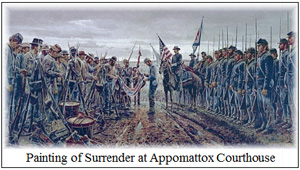 Hewitt
said, of all his mentor, Prof. T. Harry Williams' lectures, his most
popular, and his favorite, was the final lecture for each Civil War
class. He brought many in the audience to tears as he read a passage
from a 1901 article by Joshua L. Chamberlain, who commanded the Union
soldiers at the surrender at Appomattox Courthouse: "At such a time and
under such conditions I thought it eminently fitting to show some token
of our feeling, and I therefore instructed my subordinate officers to
come to the position of [Carry Arms] 'salute' in the manual of arms as
each body of the Confederates passed before us... I may best describe it
as a marching salute in review. When General Gordon came opposite me I
had the bugle blown and the entire line came to 'attention,' preparatory
to executing this movement of the manual successively and by regiments
as Gordon's columns should pass before our front, each in turn. The
General was riding in advance of his troops, his chin drooped to his
breast, downhearted and dejected in appearance almost beyond
description. At the sound of that machine-like snap of arms, however,
General Gordon started, caught in a moment its significance, and
instantly assumed the finest attitude of a soldier. He wheeled his horse
facing me, touching him gently with the spur, so that the animal
slightly reared, and as he wheeled, horse and rider made one motion, the
horse's head swung down with a graceful bow, and General Gordon dropped
his sword point to his toe in salutation. . . .General Gordon sent back
orders to the rear that his own troops take the same position of the
manual in the march past as did our line. That was done, and a truly
imposing sight was the mutual salutation and farewell." Hewitt
said, of all his mentor, Prof. T. Harry Williams' lectures, his most
popular, and his favorite, was the final lecture for each Civil War
class. He brought many in the audience to tears as he read a passage
from a 1901 article by Joshua L. Chamberlain, who commanded the Union
soldiers at the surrender at Appomattox Courthouse: "At such a time and
under such conditions I thought it eminently fitting to show some token
of our feeling, and I therefore instructed my subordinate officers to
come to the position of [Carry Arms] 'salute' in the manual of arms as
each body of the Confederates passed before us... I may best describe it
as a marching salute in review. When General Gordon came opposite me I
had the bugle blown and the entire line came to 'attention,' preparatory
to executing this movement of the manual successively and by regiments
as Gordon's columns should pass before our front, each in turn. The
General was riding in advance of his troops, his chin drooped to his
breast, downhearted and dejected in appearance almost beyond
description. At the sound of that machine-like snap of arms, however,
General Gordon started, caught in a moment its significance, and
instantly assumed the finest attitude of a soldier. He wheeled his horse
facing me, touching him gently with the spur, so that the animal
slightly reared, and as he wheeled, horse and rider made one motion, the
horse's head swung down with a graceful bow, and General Gordon dropped
his sword point to his toe in salutation. . . .General Gordon sent back
orders to the rear that his own troops take the same position of the
manual in the march past as did our line. That was done, and a truly
imposing sight was the mutual salutation and farewell."
Gordon’s 1903 Reminiscences of the Civil War, confirmed
Chamberlain’s tale:" ...as my men marched in front of them, the veterans
in blue gave a soldierly salute to those vanquished heroes, a token of
respect from Americans to Americans, a final and fitting tribute from
Northern to Southern chivalry." Prof. Williams then shocked his students
by saying that there was no exchange of salutes. In fact
the Yankee soldiers had been taunting the defeated rebels and the
situation could easily have gotten out of hand. Any shifting of arms
that Gordon heard was the Yankees being called to Shoulder Arms
(attention), which meant they could not move and had to keep their
mouths shut. No Carry Arms (salute) was made by them, and Gordon made no
response. Chamberlain's motives for creating this myth are uncertain,
but Gordon gave credence to it as a way of uniting the postwar
generation. To date the first--and only-historian to set the record
straight is William Marvel in Lee's Last Retreat, published in
2002. The National Park Service perpetuates this benign fabrication: the
painting used to illustrate the surrender shows the Union soldiers at
Carry Arms! And the Civil War Trust reproduces Chamberlain’s 1901 Boston
Journal article quoted by Gordon in full!
Following Q&A, Prof. Hewitt received a well-deserved round of
applause.
Last changed: 03/09/14
Home
About News
Newsletters
Calendar
Memories
Links Join
|

